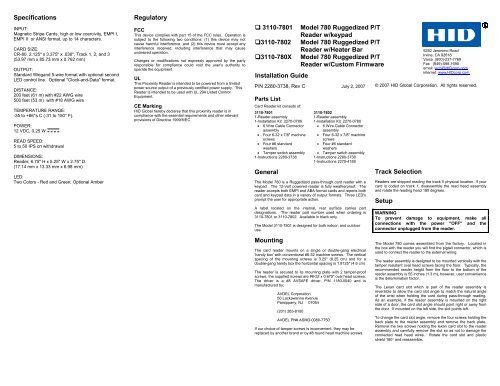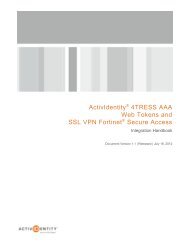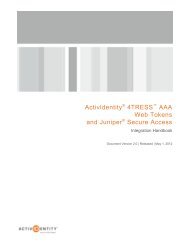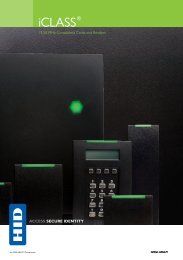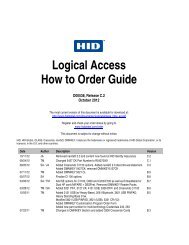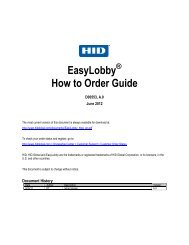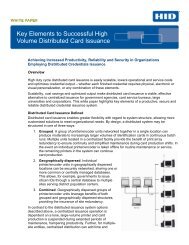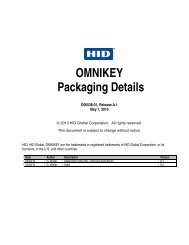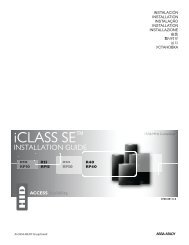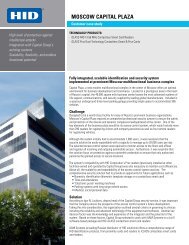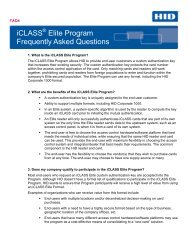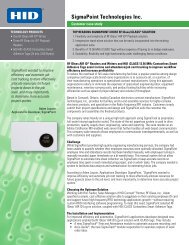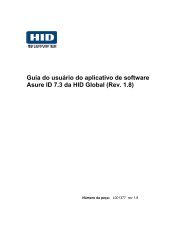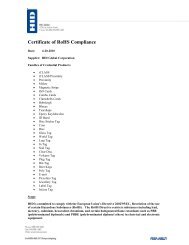Magnetic Stripe Reader 780 - HID Global
Magnetic Stripe Reader 780 - HID Global
Magnetic Stripe Reader 780 - HID Global
You also want an ePaper? Increase the reach of your titles
YUMPU automatically turns print PDFs into web optimized ePapers that Google loves.
Specifications<br />
INPUT:<br />
<strong>Magnetic</strong> <strong>Stripe</strong> Cards, high or low coercivity, EMPI I,<br />
EMPI II or ANSI format, up to 14 characters.<br />
CARD SIZE:<br />
CR-80, 2.125" x 3.375" x .030", Track 1, 2, and 3<br />
(53.97 mm x 85.73 mm x 0.762 mm)<br />
OUTPUT:<br />
Standard Wiegand 5-wire format with optional second<br />
LED control line. Optional "Clock-and-Data" format.<br />
DISTANCE:<br />
200 feet (61 m) with #22 AWG wire<br />
500 feet (53 m) with #18 AWG wire<br />
TEMPERATURE RANGE:<br />
-35 to +66°s C (-31 to 150° F).<br />
POWER:<br />
12 VDC, 0.25 W<br />
READ SPEED:<br />
5 to 50 IPS on withdrawal<br />
DIMENSIONS:<br />
<strong>Reader</strong>; 6.75" H x 5.25" W x 2.75" D.<br />
(17.14 mm x 13.33 mm x 6.98 mm)<br />
LED:<br />
Two Colors - Red and Green; Optional Amber<br />
Regulatory<br />
FCC<br />
This device complies with part 15 of the FCC rules. Operation is<br />
subject to the following two conditions: (1) this device may not<br />
cause harmful interference, and (2) this device must accept any<br />
interference received, including interference that may cause<br />
undesired operation.<br />
Changes or modifications not expressly approved by the party<br />
responsible for compliance could void the user’s authority to<br />
operate the equipment.<br />
UL<br />
This Proximity <strong>Reader</strong> is intended to be powered from a limited<br />
power source output of a previously certified power supply. This<br />
<strong>Reader</strong> is intended to be used with UL 294 Listed Control<br />
Equipment.<br />
CE Marking<br />
<strong>HID</strong> <strong>Global</strong> hereby declares that this proximity reader is in<br />
compliance with the essential requirements and other relevant<br />
provisions of Directive 1999/5/EC.<br />
� 3110-<strong>780</strong>1 Model <strong>780</strong> Ruggedized P/T<br />
<strong>Reader</strong> w/keypad<br />
�3110-<strong>780</strong>2 Model <strong>780</strong> Ruggedized P/T<br />
<strong>Reader</strong> w/Heater Bar<br />
�3110-<strong>780</strong>X Model <strong>780</strong> Ruggedized P/T<br />
<strong>Reader</strong> w/Custom Firmware<br />
Installation Guide<br />
P/N 2280-3738, Rev C July 2, 2007<br />
Parts List<br />
Card <strong>Reader</strong> kit consists of:<br />
3110-<strong>780</strong>1 3110-<strong>780</strong>2<br />
1-<strong>Reader</strong> assembly 1-<strong>Reader</strong> assembly<br />
1-Installation Kit 2270-0<strong>780</strong> 1-Installation Kit 2270-0<strong>780</strong><br />
• 6 Wire Cable Connector • 6 Wire Cable Connector<br />
assembly<br />
assembly<br />
• Four 6-32 x 7/8" machine • Four 6-32 x 7/8" machine<br />
screws<br />
screws<br />
• Four #6 standard<br />
• Four #6 standard<br />
washers<br />
washers<br />
• Tamper switch assembly • Tamper switch assembly<br />
1-Instructions 2280-3738 1-Instructions 2280-3738<br />
1-Instructions 2270-4189<br />
General<br />
The Model <strong>780</strong> is a Ruggedized pass-through card reader with a<br />
keypad. The 12-Volt powered reader is fully weatherproof. The<br />
reader accepts both EMPI and ABA format cards and reports both<br />
card and keypad data in a variety of output formats. Three LED's<br />
prompt the user for appropriate action.<br />
A label located on the internal, rear surface carries part<br />
designations. The reader part number used when ordering is<br />
3110-<strong>780</strong>1 or 3110-<strong>780</strong>2. Available in black only.<br />
The Model 3110-<strong>780</strong>1 is designed for both indoor, and outdoor<br />
use.<br />
Mounting<br />
The card reader mounts on a single or double-gang electrical<br />
'handy box' with conventional #6-32 machine screws. The vertical<br />
spacing of the mounting screws is 3.25" (8.25 cm) and for a<br />
double-gang handy box the horizontal spacing is 1.8125" (4.6 cm)<br />
The reader is secured to its mounting plate with 2 tamper-proof<br />
screws, the supplied screws are #8-32 x 0.675" oval head screws.<br />
The driver is a #8 AVSAFE driver, P/N 1180-0040 and is<br />
manufactured by;<br />
AVDEL Corporation<br />
50 Lackawanna Avenue<br />
Parsippany, NJ 07054<br />
(201) 263-8100<br />
AVDEL PN# ASMD-0080-7750<br />
If our choice of tamper screws is inconvenient, they may be<br />
replaced by another brand or by #8 round head machine screws.<br />
9292 Jeronimo Road<br />
Irvine, CA 92618<br />
Voice (800)-237-7769<br />
Fax (949)-598-1690<br />
email: tech@<strong>HID</strong>corp.com<br />
internet: www.<strong>HID</strong>corp.com<br />
© 2007 <strong>HID</strong> <strong>Global</strong> Corporation. All rights reserved.<br />
Track Selection<br />
<strong>Reader</strong>s are shipped reading the track II physical location. If your<br />
card is coded on track 1, disassemble the read head assembly<br />
and rotate the reading head 180 degrees.<br />
Setup<br />
WARNING<br />
To prevent damage to equipment, make all<br />
connections with the power "OFF" and the<br />
connector unplugged from the reader.<br />
The Model <strong>780</strong> comes assembled from the factory. Located in<br />
the box with the reader you will find the pigtail connector, which is<br />
used to connect the reader to the external wiring.<br />
The reader assembly is designed to be mounted vertically with the<br />
tamper resistant oval head screws facing the floor. Typically, the<br />
recommended reader height from the floor to the bottom of the<br />
reader assembly is 55 inches (1.3 m), however, user convenience<br />
is the determination factor.<br />
The Lexan card slot which is part of the reader assembly is<br />
reversible to allow the card slot angle to match the natural angle<br />
of the wrist when holding the card during pass-through reading.<br />
As an example, if the reader assembly is mounted on the right<br />
side of a door, the card slot angle should point right or away from<br />
the door. If mounted on the left side, the slot points left.<br />
To change the card slot angle, remove the four screws holding the<br />
back plate to the reader assembly and remove the back plate.<br />
Remove the two screws holding the lexan card slot to the reader<br />
assembly and carefully remove the slot so as not to damage the<br />
connected read head wires. Rotate the card slot and plastic<br />
shield 180° and reassemble.
Electrical Connections Installation Instructions<br />
Powering ON & Self Test Diagnostic Tests<br />
Connections from the reader cable to the host cable should be<br />
crimped or made with twist-on wire nuts. Unplug the reader<br />
connector before making the following splices:<br />
Control and data lines are normally High (+5V) when idle and<br />
pulled too common when active (less than 1V).<br />
Two 22 AWG white wires convey the status of a tamper switch<br />
that indicates whether the reader is properly mounted or<br />
detached. The switch is CLOSED when the reader is mounted<br />
and OPEN when it is detached.<br />
Option Switches<br />
To set the reader options, you must know:<br />
� Are the cards coded with EMPI or ABA data?<br />
� Are the cards coded on Track I or Track II?<br />
� Does the host system expect Wiegand 26 bit, Wiegand 34 bit<br />
or clock-and-data format ?<br />
A miniature Dip switch which can be accessed from the back of<br />
the reader selects the following standard options:<br />
Standard Option Switch Settings<br />
A B C<br />
off off off ABA card into LinxRead panel<br />
off on off EMPI card to Wiegand 26 bit<br />
off on on EMPI card to Wiegand 34 bit<br />
on off off ABA card to Clock & Data bits<br />
on on off 10 or 12 digit ABA Card to<br />
Wiegand 26 bit<br />
on on on 10 or 12 digit ABA card to<br />
Wiegand 34 bit<br />
on off on ABA card to Wiegand bits<br />
These selections cover the most common uses. If they do not<br />
serve your application, consult your system supplier for their setup<br />
method.<br />
NOTE: If you have custom reader models 3110-<strong>780</strong>1-S,<br />
3110-<strong>780</strong>3, or <strong>780</strong>1-SD0XX, please refer to the table below:<br />
Custom Option Switch Settings<br />
Model Switch Position<br />
Function<br />
(3110-) A B C D<br />
<strong>780</strong>1-S X X ON X ABA Cardkey Phila.<br />
Airport<br />
<strong>780</strong>3 X ON X X EMPI 26bit Wiegand<br />
<strong>780</strong>1-<br />
SD016<br />
PIN<br />
1<br />
FUNCTION<br />
+12 VDC<br />
WIRE COLOR<br />
RED<br />
2 LED Control Line A BROWN<br />
3 Data "1" /Data WHITE<br />
4 Data "0" /Clock GREEN<br />
5 COMMON BLACK<br />
6 LED Control Line B YELLOW<br />
ON X X X CSI 19 digit ISO Clock<br />
& Data<br />
ON ON X X ANSI /10 / 12 to 26<br />
bit-Wiegand<br />
ON ON X ON 26 bit output Cardlock<br />
Format<br />
ON ON ON ON 34 bit output Cardlock<br />
Format<br />
CAUTION Upon first application of power, the reader does a self-test<br />
Before touching any internal reader parts, touch a grounded<br />
surface to discharge static electricity from your body.<br />
1. If not mounting to an electrical handy-box, select a suitable<br />
flat surface and use the mounting plate both as a template to<br />
establish drill hole location and as a guide to remove<br />
sufficient material to allow clearance for connection of the<br />
pig-tail to the wiring cable, and the tamper switch. The<br />
tamper switch can be found in the hardware package. If<br />
desired, it can be installed either as shown, or to the back<br />
plate with the tamper switch plunger facing the mounting<br />
plate. A hole in the back plate is provided for this purpose.<br />
2. Pull the required cable between host controller and reader<br />
mounting location. Connect the wire cable to the host.<br />
3. To install, you must first disassemble the reader assembly<br />
from the mounting plate. Use the special oval head screw<br />
driver (AVSAFE driver obtained separately) to loosen the (2)<br />
tamper resistant oval head screws from the bottom of the<br />
reader.<br />
NOTE: It is not necessary to fully remove screws. Just loosen<br />
enough to remove the mounting plate. This will simplify<br />
re-assembly.<br />
4. Attach the provided pigtail connector to the wire cable at the<br />
mounting location. Connections can be crimped or made<br />
with twist-on wire nuts. Follow the appropriate color code<br />
and wire lead function.<br />
5. Pass the connector through the cutout in the mounting plate,<br />
and mount the plate to the mounting surface using the<br />
appropriate mounting holes in the plate. The type of<br />
mounting bolts (not provided) will be determined locally by<br />
the installer. They must provide a strong secure mounting.<br />
6. Make sure the wire nuts, or crimped connectors are located<br />
in the wall cavity, and only the pigtail connector passes<br />
through the mounting plate.<br />
7. Plug the connector into the back of the reader circuit board.<br />
The connector is designed to fit only one way. Carefully<br />
align the pin terminals of the circuit board with the<br />
corresponding holes in the connector and gently push<br />
together with a slight rocking motion.<br />
If not already accomplished, set the appropriate option<br />
switches on the back of the reader circuit board.<br />
8. Attaching the reader assembly to the mounting plate is the<br />
reverse of disassembly. Carefully align the (4) mounting<br />
tabs on the mounting plate with their corresponding slots in<br />
the back plate. Make sure the (2) oval head screws until the<br />
reader assembly is pulled firmly against the mounting<br />
surface. Do not over tighten these screws.<br />
NOTE: This operation also depresses the tamper switch<br />
plunger.<br />
9. Test the reader as appropriate.<br />
sequence. Observe that the reader's green LED flashes four<br />
times.<br />
If the reader does not make the above confirmation or continues<br />
with short double flashes, the self-test has failed and the reader<br />
must be replaced.<br />
If the reader completes the self-test by flashing the LED but will<br />
not read cards the following steps apply:<br />
1. Check that the voltage at the red and black wires is between<br />
8.0 and 13.0 volts DC.<br />
2. Verify wiring to the host controller.<br />
3. Test reader by exchanging with another unit.<br />
4. Do not attempt to adjust the reading head or its mount. It is<br />
factory calibrated and not field serviceable.<br />
Internal damage or electronic failure requires replacement of the<br />
complete reader.


